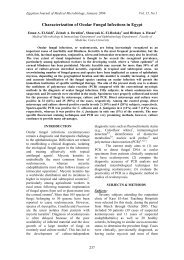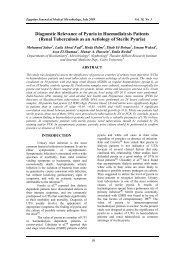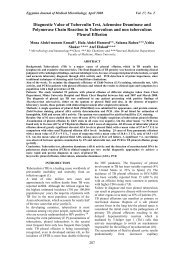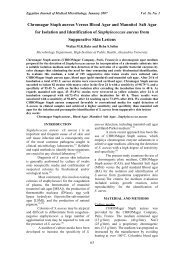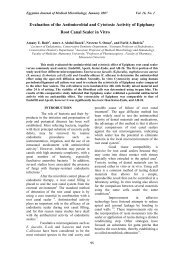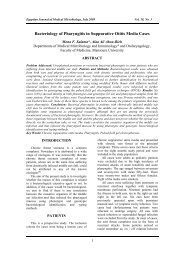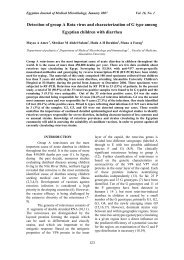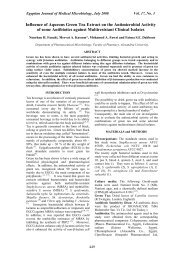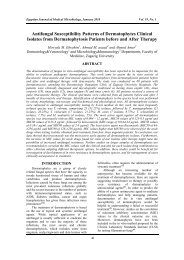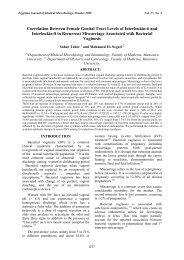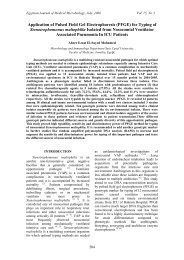Strain differentiation of Mycobacterium tuberculosis complex ...
Strain differentiation of Mycobacterium tuberculosis complex ...
Strain differentiation of Mycobacterium tuberculosis complex ...
Create successful ePaper yourself
Turn your PDF publications into a flip-book with our unique Google optimized e-Paper software.
Egyptian Journal <strong>of</strong> Medical Microbiology, January 2008 Vol. 17, No. 1<br />
<strong>Strain</strong> <strong>differentiation</strong> <strong>of</strong> <strong>Mycobacterium</strong> <strong>tuberculosis</strong> <strong>complex</strong> isolated<br />
from sputum <strong>of</strong> Pulmonary Tuberculosis Patients<br />
1<br />
Abbadi Said, 1 El Hadidy Gehan, 1 Gomaa Nahed, and 2 Robert Cooksey<br />
1 Microbiology & Immunology Department, Faculty <strong>of</strong> Medicine, Suez Canal University, and 2 The<br />
Division <strong>of</strong> AIDS, STD, and TB Laboratory Research, Centers for Disease Control, Atlanta, USA<br />
ABSTRACT<br />
We characterized 45 <strong>Mycobacterium</strong> <strong>tuberculosis</strong> <strong>complex</strong> (MTC) isolates from sputum samples <strong>of</strong> Egyptian<br />
patients with pulmonary <strong>tuberculosis</strong>. One M. bovis and 44 M. <strong>tuberculosis</strong> (MTB) isolates were identified by<br />
PCR RFLP analysis <strong>of</strong> OxyR gene. Twenty-five (56.8%) <strong>of</strong> the 44 MTB isolates were susceptible in vitro to all<br />
anti<strong>tuberculosis</strong> drugs tested; 5 (11.4%) were mono-resistant to INH and STR (4 were resistant to STR and<br />
only one was resistant to INH); 14 (31.8%) were resistant to more than one drug (MDR) .Among the 44 MTB<br />
isolates tested for RFLP analysis in this study, 40 different RFLP patterns were obtained. The number <strong>of</strong><br />
IS6110 copies ranged from 5 to 16 (fig. 1). Studying the IS6110 RFLP patterns indicated that the 44 isolates<br />
did not cluster together but were generally scattered. None <strong>of</strong> the 15 multi-drug resistant (MDR) isolates were<br />
clustered. Twenty-two different spoligotypes were identified among the 44 MTB isolates, <strong>of</strong> which 13 were<br />
unique (Table 3). The remaining 31 isolates (%) were grouped into 9 clusters <strong>of</strong> strains sharing identical<br />
spoligotypes. We demonstrated evidence <strong>of</strong> diversity between the drug-susceptible and resistant MTB strains.<br />
Key words: pulmonary <strong>tuberculosis</strong>; IS6110 RFLP, spoligotyping.<br />
INTRODUCTION<br />
Key factors in the control <strong>of</strong> <strong>tuberculosis</strong><br />
are rapid detection, adequate therapy, and contact<br />
tracing to arrest further transmission. Recent<br />
developments in DNA technology and molecular<br />
biology have led to methods for rapid detection <strong>of</strong><br />
mycobacterial DNA by nucleic acid amplification<br />
(1). These methods include; DNA fingerprinting,<br />
based on the polymorphism <strong>of</strong> the insertion<br />
sequence IS6110 among MTB <strong>complex</strong> strains (2) ,<br />
pTBN12 fingerprinting based on the polymorphic<br />
GC rich sequence (PGRS) (3), spoligotyping<br />
based on the analysis <strong>of</strong> polymorphisms in the DR<br />
locus (1) and variable-number tandem repeats<br />
(VNTR) typing (4). Among these methods, the<br />
IS6110 fingerprinting is the recommended<br />
standard primary genotyping method (5) and has<br />
been used routinely worldwide (6). Clinical<br />
isolates <strong>of</strong> MTB obtained from patients infected<br />
by the same strain <strong>of</strong> bacillus usually exhibit<br />
identical or very similar (with one band variation)<br />
IS6110 fingerprint patterns, and the patients are<br />
more <strong>of</strong>ten found to be epidemiologically linked<br />
(7). The major limitation <strong>of</strong> the IS6110 typing is<br />
its low discriminating power for isolates with<br />
fewer than six copies <strong>of</strong> IS6110. In the case where<br />
the IS6110 is not definitive, Mycobacterial<br />
interspersed repetitive unit- variable number<br />
tandem repeat analysis (MIRU/VNTR) or<br />
spoligotyping is usually needed as a secondary<br />
typing (4]. These secondary typing methods have<br />
the advantage <strong>of</strong> being less time consuming as<br />
they are PCR-based (8).<br />
The increased application <strong>of</strong> DNA<br />
fingerprinting has advanced the understanding <strong>of</strong><br />
the dynamics <strong>of</strong> TB epidemiology (9). Molecular<br />
typing has provided insight into the impact <strong>of</strong><br />
reinfection on recurrent <strong>tuberculosis</strong> in<br />
comparison to reactivation (10). Molecular typing<br />
<strong>of</strong> MTB isolates has also proven to be useful tool<br />
in confirming laboratory cross-contamination (11)<br />
and investigating nosocomial and institutional<br />
transmission (12).<br />
This study represents early attempts at<br />
tracking diversity particularly among drugresistant<br />
strains consistent with low-incidence<br />
countries. In this study we characterized<br />
<strong>Mycobacterium</strong> <strong>tuberculosis</strong> <strong>complex</strong> (MTC)<br />
isolates from sputum <strong>of</strong> patients infected with<br />
MTB from Egypt in order to establish a database<br />
<strong>of</strong> strain types and antimicrobial susceptibility<br />
patterns. We demonstrated evidence <strong>of</strong> diversity<br />
among MDR-MTB and drug-susceptible MTB<br />
strains.<br />
MATERIALS AND METHODS<br />
Bacterial isolates:<br />
Forty- five clinical isolates (one isolate per<br />
patient) were included in this study. All specimens<br />
were isolated from sputum samples from patients<br />
with pulmonary <strong>tuberculosis</strong> at Suez Canal<br />
Region, Egypt.<br />
Isolation and Preliminary identification <strong>of</strong><br />
MTB strains: After concentration/<br />
decontamination <strong>of</strong> sputum samples by NALC<br />
method, culture <strong>of</strong> sputum was done on<br />
Lowenstein-Jensen (LJ) media. Isolation and<br />
identification <strong>of</strong> MTC were performed as<br />
described previously (13).<br />
Antimicrobial susceptibility testing<br />
Isolates <strong>of</strong> <strong>Mycobacterium</strong> <strong>tuberculosis</strong><br />
<strong>complex</strong> (MTC) were tested by the modified<br />
method <strong>of</strong> proportion as described by Kent and<br />
Kubica (13) using Middlebrook 7H10 agar plates<br />
containing rifampin (RIF), isoniazid (INH),<br />
streptomycin (STR), ethambutol (EMB) and<br />
143
Egyptian Journal <strong>of</strong> Medical Microbiology, January 2008 Vol. 17, No. 1<br />
pyrazinamide (PZA). The following critical<br />
concentrations were used: RIF(1.0 ug/ml),<br />
INH(0.2, 1.0 and 5.0 ug/ml), STR(2.0 and 10.0<br />
ug/ml), EMB(5.0 ug/ml), PZA(25.0 ug/ml).<br />
Molecular identification <strong>of</strong> MTB isolates: DNA<br />
<strong>of</strong> suspected MTB isolates was extracted by the<br />
mini-glass bead agitation procedure as previously<br />
described (15). PCR amplification <strong>of</strong> IS6110<br />
(MTB <strong>complex</strong>-specific) and IS1245 (M.aviumspecific)<br />
(14) was performed in a multiplex PCR<br />
assay.<br />
Multiplex PCR assay was performed on the<br />
purified DNA as follows: In a final volume <strong>of</strong> 25<br />
ul; 1 ul <strong>of</strong> DNA template, 0.6 ul (5 uM) <strong>of</strong> each <strong>of</strong><br />
the four primers and 12.5 ul HotStar Taq Master<br />
Mix (Taq DNA polymerase, 10x Taq buffer, 3<br />
mM MgCl 2 , and 400 uM dNTPs; Quiagen, CA,<br />
USA) were added to 9.1 uL distilled water. The<br />
primers used to amplify 123 bp fragment <strong>of</strong><br />
IS6110 were: KDE1 (5` -CCT GCG AGC GTA<br />
GGC GTC GG) and KDE2 (5` -CTC GTC CAG<br />
CGC CGC TTC GG). The primers used to amplify<br />
a 378 bp fragment <strong>of</strong> IS1245 were: MA1 (5` -CTT<br />
GCT GGA GGT GCT CGA CG) and primer MA2<br />
(5` -GGA GGT GCC GTG CAG GTA GG).<br />
MTB strain H37Rv and M. avium ATCC 871031<br />
were used as PCR controls. Thermocycling was<br />
done in Gene-Amp PCR system 9700<br />
Thermocycler (Perkin-Elmer Inc., CA). PCR<br />
conditions were as follows: initial denaturation at<br />
96 o C for 15 min, then 35 cycles composed <strong>of</strong><br />
denaturation at 96 o C for 30 sec, annealing at 64<br />
o C for 30 sec, and extension at 72 o C for 30 sec.<br />
Final extension at 72 o C for 7 min was done at the<br />
end <strong>of</strong> cycles. PCR amplicons were<br />
electrophoresed through 2% agarose gel<br />
supplemented with 50 ug ethidium bromide, at<br />
100 V for 1 hr. DNA bands were visualized by<br />
UV transilluminator, and compared to control<br />
strains.<br />
PCR RFLP analysis <strong>of</strong> OxyR gene: Isolates<br />
were further characterized Using PCR RFLP<br />
analysis <strong>of</strong> OxyR gene to differentiate between M.<br />
bovis & M. <strong>tuberculosis</strong> within the MTB <strong>complex</strong>.<br />
A 548 bp segment <strong>of</strong> the OxyR gene was<br />
amplified as described previously (16 ) using the<br />
following oligonucleotide primers: forward<br />
primer, 5 ’GGT GAT ATA TCA CAC CATA-3 ’ ;<br />
reverse primer , 5 ’ – CTA TGC GAT CAG GCG<br />
TAC TTG-3’. The following cyclic conditions<br />
were used for amplification <strong>of</strong> the OxyR gene:<br />
denaturation at 96 o C for 5 min, 35 cycles <strong>of</strong> 30<br />
sec at 96 o C, 30 sec at 57 o C, 45 sec at 72 o C and<br />
finally extension for 6 min at 72 o C. DNA gel<br />
Electrophoresis was done to test the amplification<br />
using 2% agarose gel under 100 V for 1 hour. the<br />
PCR product (10 ul) was digested with 4 U <strong>of</strong> AluI<br />
( New England Biolabs, Beverly, Mass., USA),<br />
the reaction mix included 12 ul water, 2.5 ul<br />
enzyme buffer, and 10 ul PCR product. 100 bp<br />
marker was used as a ladder. 4-20% Novex precast<br />
acrylamide gel was used for doing the gel<br />
electrophoresis for 3 hours, at 100V, using TBE<br />
buffer cooled to 6 o C.<br />
<strong>Strain</strong> typing (IS6110 RFLP)<br />
Isolates <strong>of</strong> MTB were typed by the<br />
standard IS6110-RFLP method as described by<br />
van Embden et al (5). In brief, a 2-3 week old<br />
subculture isolates in 7H9 broth was incubated<br />
overnight with cycloserine (1 mg/ml) at 37 o C. The<br />
sedimented cells were harvested to 1.5 ml<br />
microcentrifuge tube and incubated for 20 min at<br />
80 o C. Chromosomal DNA was isolated by<br />
disruption <strong>of</strong> cells with siliconized glass beads as<br />
described previously (14). About 0.75 to 1.25 ug<br />
<strong>of</strong> genomic DNA was digested for 2 h with 10 U<br />
<strong>of</strong> pvuII (BRL Life technologies Inc., Gaitherburg,<br />
MD) and electrophoresed on 1.0% agarose gel<br />
electrophoresis overnight. The restriction<br />
fragments were transferred by vacuum blotting to<br />
a Hybond-N+ nylon membrane (Amersham Corp.,<br />
Arlington heights, IL). Hybridization was carried<br />
out under stringent conditions with 247-bp IS6110<br />
PCR fragment, using the Amersham ECL direct<br />
labeling and detection kit. Banding patterns on<br />
resulting autoradiographs were scanned and<br />
analyzed using molecular analysis s<strong>of</strong>tware (Bio<br />
Image, Ann Arbor, MI) (14).<br />
Spoligotyping<br />
Spoligotyping was performed as previously<br />
described by Kamerbeek et al., (17). The direct<br />
repeat (DR) region was amplified by PCR using<br />
primers derived from the DR sequence. The<br />
primers used were DRa<br />
(GGTTTTGGGTCTGACGAC) and DRb<br />
(CCGAGAGGGGACGGAAAC). Fifty<br />
microliters <strong>of</strong> the following reaction mixture were<br />
used for the PCR: 10 ng <strong>of</strong> DNA, 20 pmol each <strong>of</strong><br />
primers DRa and DRb, each deoxynucleoside<br />
triphosphate at 200 mM, PCR buffer, and 0.5 U <strong>of</strong><br />
taq polymerase. The mixture was heated for 3 min<br />
at 96C and subjected to 20 cycles <strong>of</strong> 1 min at 96C,<br />
1 min at 55C, and 30 s at 72C. The amplified<br />
DNA was hybridized to a set <strong>of</strong> 43 immobilized<br />
oligonucleotides, each corresponding to one <strong>of</strong> the<br />
unique spacer DNA sequences within the D R<br />
locus. The sequences <strong>of</strong> the oligonucleotides used<br />
are given in table 1. These oligonucleotides were<br />
covalently bound to a Hybridization membrane.<br />
The membrane (Biodyne C) was obtained from<br />
Pall Biosupport, Portsmouth, UK, and was<br />
activated as previously described (17). For<br />
hybridization, 20 ul <strong>of</strong> the amplified PCR product<br />
was diluted in 150ul <strong>of</strong> 2X SSPE supplemented<br />
with 0.1% sodium dodecyl sulfate and heat<br />
denatured. The diluted samples (130ul) were<br />
pipetted into the parallel channels in such a way<br />
that the channels <strong>of</strong> the miniblotter apparatus were<br />
perpendicular to the rows <strong>of</strong> oligonucleotides<br />
deposited previously. Hybridization was done for<br />
60 min at 60C. After hybridization, the membrane<br />
was washed as previously described (17).<br />
144
Egyptian Journal <strong>of</strong> Medical Microbiology, January 2008 Vol. 17, No. 1<br />
Detection <strong>of</strong> hybridizing DNa was done by using<br />
chemiluminescent ECL (Amersham) detection kit.<br />
The 43-digit binary result is converted to a 15-<br />
digit octal designation as previously described<br />
(18).<br />
Table 1 Sequences <strong>of</strong> the oligonucleotides used in the study.<br />
Space Oligonucleotide sequence<br />
Space Oligonucleotide sequence<br />
No.<br />
No.<br />
1 ATAGAGGGTCGCCGGTTCTGGATCA 23 AGCATCGCTGATGCGTCCAGCTCG<br />
2 CCTCATAATTGGGCGACAGCTTTTG 24 CCGCCTGCTGGGTGAGACGTGCTCG<br />
3 CCGTGCTTCCAGTGATCGCCTTCTA 25 GATCAGCGACCACCGCACCCTGTCA<br />
4 ACGTCATACGCCGACCAATCATCAG 26 CTTCAGCACCACCATCATCCGGCGC<br />
5 TTTTCTGACCACTTGTGCGGGATTA 27 GGATTCGTGATCTCTTCCCGCGGAT<br />
6 CGTCGTCATTTCCGGCTTCAATTTC 28 TGCCCCGGCGTTTAGCGATCACAAC<br />
7 GAGGAGAGCGAGTACTCGGGGCTGC 29 AAATACAGCTCCACGACACGACCA<br />
8 CGTGAAACCGCCCCCAGCCTCGCCG 30 GGTTGCCCCGCGCCCTTTTCCAGCC<br />
9 ACTCGGAATCCCATGTGCTGACAGC 31 TCAGACAGGTTCGCGTCGATCAAGT<br />
10 TCGACACCCGCTCTAGTTGACTTCC 32 GACCAAATAGGTATCGGCGTGTTCA<br />
11 GTGAGCAACGGCGGCGGCAACCTGG 33 GACATGACGGCGGTGCCGCACTTGA<br />
12 ATATCTGCTGCCCGCCCGGGGAGAT 34 AAGTCACCTCGCCCACACCGTCGAA<br />
13 GACCATCATTGCCATTCCCTCTCCC 35 TCCGTACGCTCGAAACGCTTCCAAC<br />
14 GGTGTGATGCGGATGGTCGGCTCGG 36 CGAAATCCAGCACCACATCCGCAGC<br />
15 CTTGAATAACGCGCAGTGAATTTCG 37 CGCGAACTCGTCCACAGTCCCCCTT<br />
16 CGAGTTCCCGTCAGCGTCGTAAATC 38 CGTGGATGGCGGATGCGTTGTGCGC<br />
17 GCGCCGGCCCGCGCGGATGACTCCG 39 GACGATGGCCAGTAAATCGGCGTGG<br />
18 CATGGACCCGGGCGAGCTGCAGATG 40 CGCCATCTGTGCCTCATACAGGTCC<br />
19 TAACTGGCTTGGCGCTGATCCTGGT 41 GGAGCTTTCCGGCTTCTATCAGGTA<br />
20 TTGACCTCGCCAGGAGAGAAGATCA 42 ATGGTGGGACATGGACGAGCGCGAC<br />
21 TCGATGTCGATGTCCCAATCGTCGA 43 CGCAGAATCGCACCGGGTGCGGGAG<br />
22 ACCGCAGACGGCACGATTGAGACAA<br />
RESULTS<br />
MTC was cultured from sputum samples<br />
from 45 patients with a presumptive diagnosis <strong>of</strong><br />
pulmonary <strong>tuberculosis</strong> from Suez Canal region.<br />
All isolates contained IS6110 based upon PCR<br />
amplification <strong>of</strong> a 123-bp region <strong>of</strong> the insertion<br />
element. Among the 45 human isolates, one<br />
human isolate was determined to be M. bovis and<br />
44 were M. <strong>tuberculosis</strong> based upon amplification<br />
<strong>of</strong> 270- bp region <strong>of</strong> oxyR.<br />
Antimicrobial Susceptibility testing<br />
Twenty-5ive (56.8%) <strong>of</strong> the 44 MTB isolates<br />
were susceptible in vitro to all anti<strong>tuberculosis</strong><br />
drugs tested; 5 (11.4%) were mono-resistant to<br />
INH and STR (4 were resistant to STR and only<br />
one was resistant to INH); 14 (31.8%) were<br />
resistant to more than one drug (MDR). The 14<br />
MDR strains included 6 strains resistant to 4<br />
drugs, 3 resistant to INH, RIF, 3 resistant to INH<br />
and STR, one resistant to INH, RIF and EMB,<br />
and one resistant to INH, RIF and STR (Table 2).<br />
<strong>Strain</strong> types (IS6110 RFLP)<br />
Among the 44 MTB isolates tested for<br />
RFLP analysis in this study, 40 different RFLP<br />
patterns were obtained (table 3). The number <strong>of</strong><br />
IS6110 copies ranged from 5 to 16 (fig. 1).<br />
Studying the IS6110 RFLP patterns indicated that<br />
the 44 isolates did not cluster together but were<br />
generally scattered. Eight isolates were clustered<br />
together in 4 patterns, 2 isolates each. These two<br />
pairs <strong>of</strong> isolates had more than 90 % similarity but<br />
still had one difference in IS6110-hybridization<br />
band within each pair. The MDR-TB isolates did<br />
not cluster together.<br />
Spoligotyping<br />
Twenty-two different spoligotypes were<br />
identified among the 44 MTB isolates, <strong>of</strong> which<br />
13 were unique (Table 3). The remaining 31<br />
isolates (%) were grouped into 9 clusters <strong>of</strong> strains<br />
sharing identical spoligotypes. One <strong>of</strong> these<br />
clusters contained 12 isolates (%) and represented<br />
the most frequently observed type, which was<br />
designated as spoligotype A. The other major<br />
spoligotypes H & G, were observed for 4 (%) and<br />
3 (%) isolates respectively. While Spoligotypes C,<br />
E, I, K, M, and S were observed for 2 isolates<br />
(3.50%) (Fig. 2).<br />
145
Egyptian Journal <strong>of</strong> Medical Microbiology, January 2008 Vol. 17, No. 1<br />
Table 2. RFLP types according to the antimicrobial susceptibility patterns <strong>of</strong> the 44 tested M. <strong>tuberculosis</strong><br />
isolates from sputum samples <strong>of</strong> pulmonary <strong>tuberculosis</strong> patients in Egypt<br />
Resistance pattern Number <strong>of</strong> isolates RFLP patterns<br />
INH 1 32<br />
STR 4 22, 30, 5, 16<br />
RIF + INH 3 6, 15, 38<br />
INH + STR 3 2,5,17<br />
INH+RIF+STR 1 3<br />
INH+RIF+EMB 1 39<br />
INH+RIF+ STR +EMB 6 7,9,10,20,21,40<br />
None 25 Multiple *<br />
Total 44<br />
* 21 RFLP patterns.<br />
Table 3. Spoligotypes <strong>of</strong> 44 MTB isolates from sputum <strong>of</strong> patients with pulmonary <strong>tuberculosis</strong> in Egypt.<br />
Spoligotype<br />
Number <strong>of</strong><br />
Isolates<br />
Spoligotype a<br />
RFLP type (s)<br />
A b 12 777777777760771 1, 21 c , 25, 26 c , 27, 28 c ,38,39,40<br />
B 1 777777367720771 2<br />
C 2 777777377760771 9, 3<br />
D 1 777777777740171 4<br />
E 2 477677577760771 6, 19<br />
F b 1 377777607760771 5<br />
G 3 437777777760771 20, 7, 10<br />
H b 4 777777607760771 8, 12, 32, 33<br />
I b 2 703777740003171 31, 11<br />
J b 1 776377777760771 13<br />
K 2 777777607760751 14<br />
L 1 037637767760771 15<br />
M 2 770000777760771 16, 17<br />
N 1 703777740003771 22<br />
O 1 703777600003171 29<br />
P 1 776367777760771 30<br />
Q 1 777777601760771 24<br />
R 1 777777347760471 35<br />
S 2 777777777620771 23, 34<br />
T 1 677777777413731 37<br />
U 1 776377740000031 36<br />
V 1 777737607760771 18<br />
Total 44 40<br />
a, 15-digital octal code (REF).<br />
b, Types were found among Egyptian isolates isolates in previous studies.<br />
c, each FRLP pattern contain 2 isolates.<br />
146
Egyptian Journal <strong>of</strong> Medical Microbiology, January 2008 Vol. 17, No. 1<br />
RFLP Patterns<br />
S 1 2 5 6 7 8 9 11 1 4 14 17 18 22 23 25 28 28 40 S<br />
FIG. 1: IS6110 RFLP Patterns <strong>of</strong> 18 M. <strong>tuberculosis</strong><br />
Isolates. S, size standard.<br />
H37Rv<br />
BCG<br />
Water<br />
Clinical samples<br />
a<br />
Figure 2. Spoligotypes from amplified mycobacterial DNA <strong>of</strong> purified M. <strong>tuberculosis</strong> DNA from strain<br />
H37Rv (lanes 1), purified M. bovis from strain BCG (lanes 2) and M. <strong>tuberculosis</strong> DNA strains<br />
cultured from clinical specimens lanes (4-40).<br />
147
Egyptian Journal <strong>of</strong> Medical Microbiology, January 2008 Vol. 17, No. 1<br />
DISCUSSION<br />
Epidemiologic studies <strong>of</strong> <strong>tuberculosis</strong> can<br />
be greatly facilitated by the application <strong>of</strong> strainspecific<br />
markers. The discoveries <strong>of</strong> transposable<br />
elements in <strong>Mycobacterium</strong> <strong>tuberculosis</strong> have<br />
been shown to be <strong>of</strong> great potential for use in<br />
strain identification.<br />
This study represents early attempts at<br />
tracking diversity particularly among drugresistant<br />
strains consistent with low-incidence<br />
countries. In this study we characterized<br />
<strong>Mycobacterium</strong> <strong>tuberculosis</strong> <strong>complex</strong> (MTC)<br />
isolates from sputum <strong>of</strong> patients infected with<br />
MTB from Egypt in order to establish a database<br />
<strong>of</strong> strain types and antimicrobial susceptibility<br />
patterns.<br />
Among the 45 MTC isolates from sputum<br />
samples obtained from Suez Canal Hospitals in<br />
Egypt, 44 were identified as MTB and one as M.<br />
bovis by PCR-RFLP analysis <strong>of</strong> oxyR. This<br />
finding suggests that M. bovis plays a minor role,<br />
compared to MTB, in the etiology <strong>of</strong> pulmonary<br />
<strong>tuberculosis</strong> in Egypt. We found 40 IS6110 RFLP<br />
patterns among the 44 MTB isolates tested. None<br />
<strong>of</strong> these patterns may be considered low-copy<br />
number (
Egyptian Journal <strong>of</strong> Medical Microbiology, January 2008 Vol. 17, No. 1<br />
Greenland and Denmark. J. Clin. Microbiol. 32:3018-<br />
3025.<br />
8. Jasmer R M, Hahn J A, Small P M, et al. 1999. A<br />
molecular epidemiologic analysis <strong>of</strong> <strong>tuberculosis</strong> trends<br />
in San Francisco, 1991-1997. Annals <strong>of</strong> Int Med. 130:<br />
971-978.<br />
9. Bifani, P. J., B. B. Plikaytis, Vkapur, K. Stockbauer,<br />
X. Pan, M. L. Lutfey, S. L. Moghazeh, W. Eisner, T.<br />
M. Daniel, M.H. Kaplan, J. T. Crawford, J. M.<br />
Musser, and B. N. Krreiswirth. 1996. Origin and<br />
interstate spread <strong>of</strong> a New York City multidrugresistant<br />
<strong>Mycobacterium</strong> <strong>tuberculosis</strong> clone family.<br />
JAMA 275: 452-457.<br />
10. van Rie, A., R. Warren, M. Richardson, T. C.<br />
Victor, R. P. Gie, D. A. Enarson, N. Beyers, and P.<br />
D. van Helden. 1999. Exogenous reinfection as a<br />
cause <strong>of</strong> recurrent <strong>tuberculosis</strong> after curative treatment.<br />
N. Engl. J. Med. 341:1174-1179.World Health<br />
Organization. 1998. Global <strong>tuberculosis</strong> control: WHO<br />
report 1998.<br />
11. Small, P. M., N. B. McClenny, S. P. Singh, G. K.<br />
Schoolnik, L. S. Tomkins, P. A. Mickelsen. 1993.<br />
Molecular strain typing <strong>of</strong> <strong>Mycobacterium</strong> <strong>tuberculosis</strong><br />
to confirm cross-contamination in the<br />
mycobacteriology laboratory and modification <strong>of</strong><br />
procedures to minimize occurrence <strong>of</strong> false-positive<br />
cultures. J. Clin. Microbiol. 31:1677-1682.<br />
12. Dooley, S. W., M. E. Villarino, M. Lawrence, L.<br />
Salinas, S. Amil, J. V. Rullan, W. R. Jarvis, A. B.<br />
Block, and G. M. Cauthen. 1992. Nosocomial<br />
transmission <strong>of</strong> <strong>tuberculosis</strong> in a hospital unit for HIVinfected<br />
patients. JAMA. 267:2632-2635.<br />
13. Kent P. T. and J. P. Kubica 1985. Public Health<br />
Mycobacteriology: A guide for the level III laboratory.<br />
U.S. Department <strong>of</strong> Health and human services<br />
publication no. 86-8230. U.S. Department <strong>of</strong> Health<br />
and human services, Washington D.C, p. 159-184.<br />
14. Kremer, K., D. van Soolingen, R. Frothingham, W.<br />
H. Haas, P. W. M. Hermans, C. Martin, P.<br />
Palitapongarnpim, B. B. Plikaytis, L. W. Riley, M.<br />
A. Yakrus, J. M. Musser, and J. D. A. van Embden.<br />
1999. Comparison <strong>of</strong> methods based on different<br />
molecular epidemiological markers for typing <strong>of</strong><br />
<strong>Mycobacterium</strong> <strong>tuberculosis</strong> <strong>complex</strong> strains:<br />
interlaboratory study <strong>of</strong> discriminatory power and<br />
reproducibility. J. Clin. Microbiol. 37:2607-2618.<br />
15. McAdam, R.A., P.W.M. Hermans, D. van<br />
Soolingen, Z.F. Zainuddin, D.Catty, J.D.A. van<br />
Embden and J.W.Dale. 1990. Characterization <strong>of</strong> a<br />
M. <strong>tuberculosis</strong> insertion seqence belonging to the IS3<br />
family. Mol. Microbiol. 4:1607-1613.<br />
16. Abbadi S.H. 2001. Use <strong>of</strong> PCR –RFLP analysis <strong>of</strong><br />
oxyR gene to differentiate between <strong>Mycobacterium</strong><br />
<strong>tuberculosis</strong> and <strong>Mycobacterium</strong> bovis. Egy. J. Med.<br />
Microbiol. 10 (4): 809-813.<br />
17. Kamerbeek, J., L. Schouls, A. Kolk, M. van<br />
Agtervveld, D. van Soolingen, S. Kuijper, A.<br />
Bunschoten, H. Molhuizen, R. Shaw, M. Goyal, and<br />
J. D. A. van Embden. 1997. Simultaneous detection<br />
and strain <strong>differentiation</strong> <strong>of</strong> <strong>Mycobacterium</strong><br />
<strong>tuberculosis</strong> for diagnosis and epidemiology. J. Clin.<br />
Microbiol. 35:907-914.<br />
18. Dale, J.W. , D. Brittain, A. A. Cataldi, D. Cousins, J.<br />
T. Crawford, J. Driscoll, H. Heersma, T. Lillebaek,<br />
T. Quitugua, N. Rastogi, R. A. Skuce, C. Sola, D.<br />
van Soolingen, and V. Vincent. 2oo1. Spacer<br />
oligonucleotide typing <strong>of</strong> bacteria <strong>of</strong> the<br />
mycobacterium <strong>tuberculosis</strong> <strong>complex</strong>:<br />
recommendations for standard nomenclature. Int. J.<br />
Tuber. Lung Dis. 5: 216-219<br />
19. Cooksey RC, Abbadi SH, Woodley CL, Sikes D,<br />
Wasfy M, Crawford JT, Mahoney F. 2002.<br />
Characterization <strong>of</strong> <strong>Mycobacterium</strong> <strong>tuberculosis</strong><br />
<strong>complex</strong> isolates from the cerebrospinal fluid <strong>of</strong><br />
meningitis patients at six fever hospitals in Egypt. J<br />
Clin Microbiol. 40(5):1651-5.<br />
20. Abbadi, S., H. G. Rashed, G. P. Morlock, C. L.<br />
Woodley, O. El Shannawy, and R. C. Cooksey.<br />
2001. Characterization <strong>of</strong> IS6110 Restriction fragment<br />
length polymorphisms patterns and mechanisms <strong>of</strong><br />
antimicrobial resistance for Multidrug-resistant isolates<br />
<strong>of</strong> <strong>Mycobacterium</strong> <strong>tuberculosis</strong> from a major reference<br />
hospital in Assuit, Egypt. J. Clin. Microbiol. 39: 2330-<br />
2334.<br />
21. Girgis, N., Y. Sultan, Z. Farid, M. Mansour, M.<br />
Erian, L. Hanna, and A. Mateczun. 1998.<br />
Tuberculous meningitis, Abbassia Fever Hospital-<br />
Naval Medical Research Unit No. 3-Cairo, Egypt, from<br />
1976 to 1996. Am. J. Trop. Med. Hyg. 58:28-34.<br />
22. El Moghazy, E. 1997. National <strong>tuberculosis</strong> program<br />
report, Epidemiological review and action plan.<br />
Egyptian Ministry <strong>of</strong> Health, Cairo, Egypt.<br />
149
Egyptian Journal <strong>of</strong> Medical Microbiology, January 2008 Vol. 17, No. 1<br />
التفريق بين سلالات ميكروب الدرن الرئوى المختلفة و المعزولة<br />
من بصاق مرضى الدرن الرئوى<br />
سعيد حامد عبادى، جيهان الحديدى، ناهد جمعة، ، روبرت آوآسى<br />
قسم الميكروبيولوجى والمناعة- آلية طب قناة السويس،<br />
مرآز التحكم فى الامراض- اتلانتا-امريكا<br />
من اهم وسائل مقاومة مرض الدرن الرئوى هو وجود وسيلة سريعة للتشخيص، العلاج المناسب وآذلك معرفة نوع<br />
السلالات المعزولة لتحديد مصدر العدوى. وبعد التطور الهائل فى استخدام تقننيات الحامض انووى ظهرت وسائل<br />
عديدة يمكن استخدامها فى معرفة نوع السلالت المعزولة.<br />
وفى هذه الدراسة تم الاعتماد على وسيلتى التحليل الجينى لجين اى اس ٦١١٠، والتحليل الجينى لتعددية الشكلية<br />
الموجودة فى جين يى ار للتفريق بين ٤٥ سلالة من سلالات ميكروب الدرن<br />
وقد اظهرت الدراسة وجود ٤٤ سلالة من ميكروب الدرن الرئوى وسلالة واحدة من ميكروب الميكوبكتيريم بوفس<br />
وذلك بافحص نواتج تقطيع جين اوآى ار بعد تكبيره بتفاعل البلمرة المتسلسل. آما اظهرت الدراسة وجود<br />
سلالة متعددة المقاومة لادوية الدرن<br />
١٤<br />
.<br />
وباستخدام التحليل الجينى لجين اى اس ٦١١٠ تبين وجود٤٠ نوع مختلف من بين ال٤٤ سلالة لميكروب الدرن<br />
الرئوى (منهم<br />
٣٦ نوع فريد ،<br />
٤ انواع يشمل آل نوع سلالتين). آما تم تقسيم نفس ال٤٤ سلالة الى<br />
٢٢ نوع<br />
مختلف باستخدام طريقة التحليل الجينى لتعددية الشكلية الموجودة فى جين يى ار منهم ١٣ نوع فريد وتم تقسيم<br />
الباقى وعددهم ٣١ نوع الى ٩ مجوعات مختلفة. آما لوحظ عدم وجود اى تجمع للسلالات المتعددة المقاومة<br />
لادوية الدرن فى مجموعة معينة فى الطريقتين المستخدمتين فى الدراسة.<br />
150



